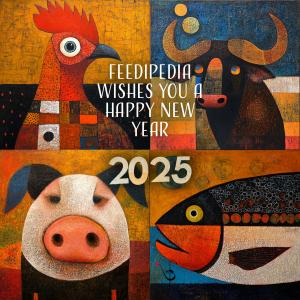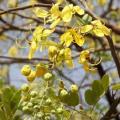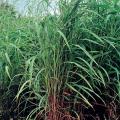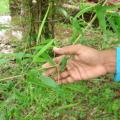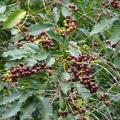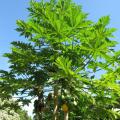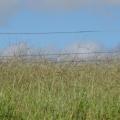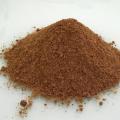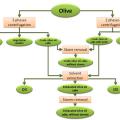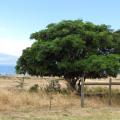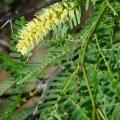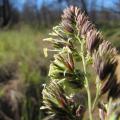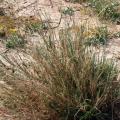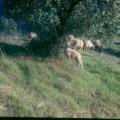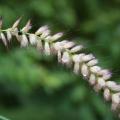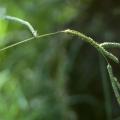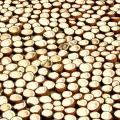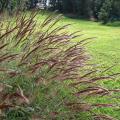Explore Feedipedia
|
African laburnum (Cassia sieberiana DC.) is a perennial legume shrub or tree, up... Read more |
Itchgrass (Rottboellia cochinchinensis (Lour.) Clayton) is an annual grass weed... Read more |
Bambusa bambos is a perennial Poaceae with a 24-32 year life cycle. It grows in... Read more |
|
The coffee bean (Coffea arabica L.) is used to make one of the most popular... Read more |
The papaya tree (Carica papaya L.) is a fast growing perennial branchless tree... Read more |
Pangola grass (Digitaria eriantha Steud) is a tropical grass widespread in many... Read more |
|
Fish meal is obtained by cooking, pressing, drying and milling fresh raw fish or fish... Read more |
Olive oil extraction generates several by-products that can be used to feed animals,... Read more |
Lebbek (Albizia lebbeck (L.) Benth.) is a deciduous, perennial medium-sized... Read more |
|
Mesquite (Prosopis juliflora (Sw.) DC), one of the 44 species of Prosopis... Read more |
Cocksfoot (Dactylis glomerata L.) is a strongly tufted, deep-rooted, long-lived... Read more |
Sewan grass (Lasiurus scindicus Henrard) is a perennial grass that can live up... Read more |
|
The olive tree (Olea europaea L.) is a slow growing evergreen tree that reaches... Read more |
Nigeria grass (Pennisetum pedicellatum Trin.) is a many-branched leafy annual... Read more |
Dallis grass (Paspalum dilatatum Poir.) is a strongly tufted, leafy, sod-forming... Read more |
|
Copra meal, or coconut meal, is an important feed ingredient and the by-product of the... Read more |
Molasses grass (Melinis minutiflora P. Beauv.) is a sticky, tufted,... Read more |
Date fruit production yields several crop residues, including date palm leaves (fronds),... Read more |
|
Corn distillers grain is the main by-product of the distillation of alcohol from maize... Read more |
Jaragua (Hyparrhenia rufa (Nees) Stapf) is a robust, tall (60-240 cm) and erect... Read more |
Columbus grass (Sorghum x almum Parodi) is a robust, tussocky, short-lived... Read more |
Pages
Recent resources
 Opinion paper: Phasing out of the aid provided to the livestock sector during expectedly recurrent emergencies
- Makkar, 2024. animal
Opinion paper: Phasing out of the aid provided to the livestock sector during expectedly recurrent emergencies
- Makkar, 2024. animal
Open access opinion paper that makes a case that the emergency aid do more harm than good to African countries. It is valid for all the fields of agriculture but has direct consequence for animal agriculture. The context here is the aid provided during emergencies that are foreseeable recurrent.
The role of livestock in food security, poverty reduction and wealth creation in West Africa
- Molina-Flores et al., 2020. Food and Agriculture Organization of the United Nations Accra, 2020
Livestock is key to 377 million people in West Africa and in some countries, up to 60% of the population is involved in livestock production. The demand for animal products is increasing with population growth, urbanization, growing middle class, and due to shifting consumer preferences towards animal products. To meet this growing demand, countries in West Africa must engage in accelerated sustainable livestock production undertaking. Livestock development is key to eradicate hunger and poverty. This book attempts to provide up-to-date, and reliable information on the potentials, opportunities, and challenges of the livestock subsector in West Africa.
Pulses and their by-products as animal feed
- Sherasia et al., 2017. In: Calles, T.; Makkar, H. P. S. (Eds), FAO, Food and Agriculture Organization of the United Nations, Rome, Italy
This document provides a state-of-the-art review of the recent research (published and unpublished) on the use of pulses and their by-products as animal feed. It aims at raising awareness on the use of pulses and their by-products. It highlights the nutritional role of pulses and pulse by-products as animal feed and is a contribution to the legacy of the 2016 International Year of Pulses. This document will further enhance the use of these feed resources in other continents, besides Asia, where many pulse by-products are simply dumped. It is also expected that the synthesis presented contributes to make the use of pulses and their by-products as animal feed more efficient. This document will be useful for extension workers, researchers, feed industry, policy-makers and donors alike.








